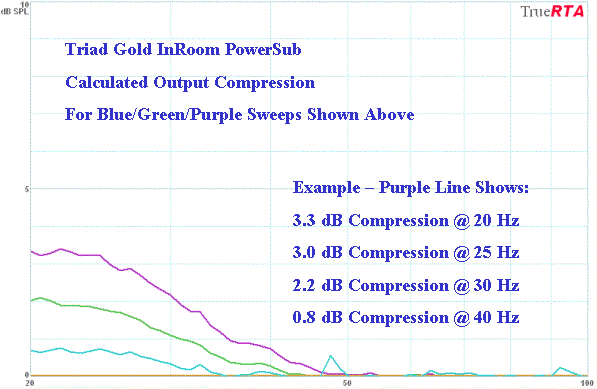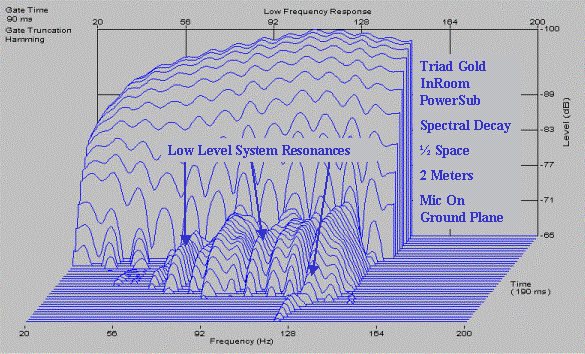On the Bench
Set-Up: All objective tests were conducted outdoors, away from any reflective
structures, with the microphone on the ground plane, facing the subwoofer,
at a distance of 2 meters from the width and depth center point of the
cabinet.
This test environment is often referred to as ½ space (2 pi steradians). In
comparison, an anechoic chamber (or suspended in free air) would be
considered full space (4 pi steradians). Testing a subwoofer in ½ space with
a 2 meter microphone distance is equivalent (in both output and frequency response)
to testing it in full space with a 1 meter microphone distance.
For the Gold PowerSub, I used the left channel 20 Hz input, the low pass
filter controls were set to 250 Hz, and the phase control was set to 00.

Frequency Response: An short-duration (about 0.5 seconds), digitally
synthesized logarithmic sine sweep was used to evaluate the frequency
response of the subwoofer. The output of the sweep was adjusted to 90 dB - 95 dB
over the majority of the pass band, and 1/6 octave smoothing was applied.
The Gold PowerSub frequency response measured 18 Hz - 250 Hz
± 3 dB,
characterized by a mild peak in the 120 Hz region. The frequency response
was very flat over the most common bass frequencies, measuring 20 Hz - 80 Hz
±
1.5 dB.
A sealed subwoofer will naturally roll-off at 12 dB/octave unless additional
high pass filtering is employed. The Gold PowerSub roll-off slope measured
12 dB/octave, indicating no additional high pass filter. According to Paul
Scarpelli, this was a deliberate decision, in order to take best advantage
of any room gain and maximize in-room deep extension.

Output Compression Testing: This test measures how loud the subwoofer can
play before its frequency response becomes non-linear. As the signal
strength is increased, all subwoofers will eventually show a reduction in
output at the lowest frequencies, and this phenomenon is known as
compression. Output compression can be caused by excessive heat in the
woofer voice coil, exceeding the mechanical limits of the woofer or passive
radiator suspension, or by exceeding port flow limits. Compression can also
be caused by amplifier limiter circuits engaging to prevent clipping or
woofer overload.
Output compression was evaluated with a 45 second logarithmic reverse sine
sweep from 100 Hz - 10 Hz. Sweeps were conducted at progressively louder (2 dB
increments) levels, and the effects of compression were noted.
As shown below, the Gold PowerSub frequency response remained linear
(uncompressed) up to the orange curve. The next three higher sweeps (blue,
green, purple) show progressively more output compression occurring. Beyond
the purple sweep level, the Gold PowerSub started to exhibit signs of
audible distress, so I terminated the test at that point. Also provided
below is a graph showing the actual amount of output compression (relative
to the orange curve) for the blue, green, and purple sweep levels.


Total Harmonic Distortion (THD): Harmonic distortion occurs when multiples
of the fundamental signal are produced due to non-linear driver behavior. A
subwoofer with low THD will sound clean and distinct, especially at the
deepest frequencies. THD was evaluated with sine waves (about 5 seconds
duration), and was limited to approximately 10% unless otherwise noted.
For a 15 woofer, the Gold PowerSub has modest clean output limits across
the pass band, only breaking 100 dB at the highest test frequencies. This
is partially due to the relatively small enclosure volume, which acts to
limit output efficiency at the lowest frequencies. As stated earlier,
maximum clean output was not a primary design goal for the Gold PowerSub.
The medium throw woofer selected for this subwoofer exhibited the cone
control and transient characteristics Triad wanted, at the expense of some
output capability.
| Frequency (Hz) |
SPL (dB) |
THD (%) |
| 20 |
80.0 |
9.9 |
| 22 |
83.5 |
10.4 |
| 25 |
86.1 |
10.2 |
| 32 |
92.0 |
10.5 |
| 40 |
95.8 |
10.3 |
| 50 |
98.7 |
9.8 |
| 63 |
101.9 |
10.3 |
| 80 |
105.4 |
9.9 |
Bandwidth Linearity: Bandwidth linearity is calculated by dividing the
average distortion-limited SPL by the maximum distortion-limited SPL, and
expressing the result as a percentage. A score of 100% means the subwoofer
exhibits perfect clean output linearity across a given bandwidth.
| Bandwidth (Hz) |
Average SPL (dB) |
Bandwidth
Linearity |
| 20-80 |
92.9 |
88% |
| 22-80 |
94.8 |
90% |
| 25-80 |
96.7 |
92% |
Phase Response and Group Delay: A
sufficiently large and abrupt phase shift may cause the perception of time
smearing at the affected frequencies. Group delay is used to quantify this
phenomenon, and was calculated at select music note frequencies. The
approximate audibility thresholds are based on extrapolations of existing
group delay audibility studies.
Due to its acoustic alignment and natural 2nd order roll-off, the Gold
PowerSub exhibited an extremely linear phase response. Group delay was very
low (virtually non-existent at 50 Hz), staying far below the approximate
audibility thresholds at each test frequency.
| Musical Note/Frequency |
Group Delay (ms) |
Approximate Audibility
Threshold (ms) |
| F2 / 87 Hz |
5.8 |
15 |
| G1 / 49 Hz |
<0.1 |
25 |
| C1 / 33 Hz |
11.4 |
35 |
| A0 / 27 Hz |
11.1 |
42 |
Impulse Response: A phase setting of 00 on the Gold PowerSub resulted
in a non-inverted impulse response. The impulse response (black line) shows
very little overshoot and system ringing for only 25 ms. This is the
shortest ring time I have yet measured, and is an excellent performance.
Considering the roll-off profile of the Gold PowerSub, I expected this type
of impulse response behavior.
Most subwoofers will ring anywhere from 25 ms - 100 ms. The amount of ringing
exhibited by a subwoofer is affected by its roll-off profile. A subwoofer
with an abrupt and steep roll-off will generally ring longer than a
subwoofer with a more gradual and shallow roll-off. While the differences in
subwoofer ring time are certainly of academic interest, readers should keep
in mind that a typical untreated listening room will exhibit modal ringing
for several hundred ms (sometimes even longer). This in-room modal ringing
will generally act to mask most differences in subwoofer ring time.

Spectral Decay: This test shows the low level spectral decay products of the
subwoofer in three dimensions along a time axis. This test can help reveal
audible cabinet and woofer resonances, or loose/vibrating parts in the
subwoofer. Spectral decay was evaluated to the 35 dB level, relative to the
test volume.
Minor system resonances were noted above 60 Hz, but none of them exceeded
25 dB in amplitude, and the largest resonance (at 120 Hz) dropped below the
35 dB test floor after about 190 ms. None of these resonances will be
audible under normal use, and in fact the overall spectral decay signature
is among the best I've seen.
It was interesting to note the almost complete absence of resonances below
about 60 Hz, which can be partially explained by the extremely well braced
and rigid enclosure. But this exceptional performance also results from the
fact that the natural (unassisted) resonance frequency of this subwoofer is
about 60 Hz. While the frequency response is extended below 60 Hz with
electronic equalization, there are clearly no additional system resonances
below this frequency.

In-Room Frequency Response
The Gold PowerSub was placed near the front left corner of my 2,000 ft3
room. For digital bass management, the main speakers were set to Small
with a crossover frequency of 80 Hz. The digital bass management circuit
imposes a 2nd order high pass filter on the speakers, and a 4th order low
pass filter on the subwoofer. The low-pass filters were set to 250 Hz to
prevent cascading with the low-pass filter in the digital bass management
circuit.
The in-room frequency response was measured at the primary listening
position (about 11 feet from the subwoofer) with the main speakers and the
subwoofer operating. Setting the subwoofer phase to 00 provided the
best results, with no obvious cancellation at the crossover frequency.
The in-room frequency response showed typical anomalies caused by room
acoustics and the asymmetrical filters in the digital bass management
circuit. I used my Rane PE-17 parametric equalizer to optimize the frequency
response, taming moderate room mode peaks. Room gain was also noted starting
below about 30 Hz. The net result of combining room gain with the Gold
PowerSub's anechoic roll-off profile is a remarkable improvement in deep
extension. The final in-room FR at the listening position was 11 Hz - 100 Hz
±
4 dB. You read that right . . . 11 Hz!

Click HERE to go to Part
III.